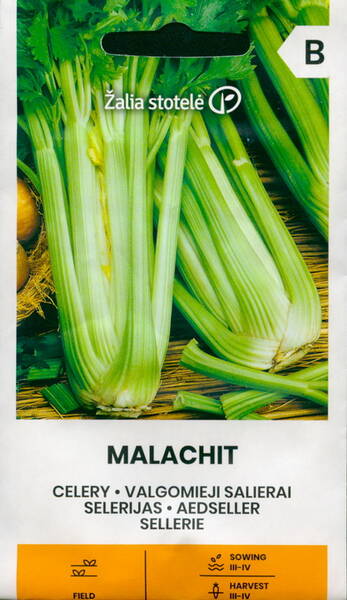A mid-early, medium-large variety of celery with dark green leaves. Leaf stalks are strong, pulpy, long and erect. The growing time from planting is approx. 75 - 85 days. Recommended spacing is 40 x 35 cm to 40 x 40 cm.
* Stalk celery is very useful for people suffering from high blood pressure, as it is able to normalize it due to the high content of calcium. In addition, fresh juice is considered an excellent blood cleanser. Due to its high sodium content, it has a salty taste, so it can be added to dishes instead of table salt.
Grow stalk celery through seedlings in the same way as root. Yes, and caring for him is simple: watering and 2-3 times feeding with complex organo-mineral fertilizer (better - liquid).
Celery is sensitive to a lack of sodium in the soil, so at the age of 30-40 days, you can feed it with a solution of table salt at the rate of 2-3 g / m2.
There is only one important nuance, ignorance of which can lead to disappointment in this vegetable: 2-3 weeks before harvesting, the petioles must be "bleached".
Thanks to this agricultural technique, the green colour is lost, the content of essential oils is reduced, and, therefore, bitterness also goes away, which allows the petioles to become juicy, tender and crispy.
European vegetable growers practice the method of planting seedlings in a groove: when the plants reach 30 cm, side shoots are removed from the celery, the petioles are wrapped with corrugated cardboard, not very tightly tied with twine and the groove is covered with soil. Before harvesting, the plants are once again highly planted with soil, which should not fall into the outlet.
To whiten the petioles of celery, once every three weeks, it is necessary to highly hill (in dry weather, so that the petioles do not rot), and then completely wrap the leaf socket in thick paper. The easiest way is to pack the petioles in opaque plastic bottles or other opaque packages with an approximate volume of about 1 litre: we cut them off on both sides, and on the resulting cylinder we make a longitudinal cut, which makes it possible to wrap it around the stems. From below, we add earth to it so that there are no cracks. From afar, it seems that someone has placed vases with celery leaves in the garden...
There are varieties of celery that do not require bleaching (Celebrity, American Green), but finding their seeds is difficult. In addition, they are less resistant to cold.
Stem celery is harvested selectively: from mid-August to late autumn. Bleached petioles are cut off at the base, and cleaned from the ground, damaged leaves are removed and carefully placed in boxes.
Bot.: Apium graveolens var. rapaceum.
* Celery is a natural, powerful aphrodisiac.
Celery is known to many as a very useful product: celery is used in cosmetology and cooking, but the most beneficial properties of celery are for men.
Celery has an antioxidant effect, and therefore it has great benefits for the male body, increasing sexual desire (libido).
This is due to the fact that celery contains a large amount of vitamins and other useful substances. All parts of the plant influence the increase in potency: roots, leaves, celery stalks.
Celery also rejuvenates the male body, normalizes blood pressure surges, lowers blood cholesterol levels, and improves immunity.
Celery root, which has a strong spicy aroma, awakens desire in men and gives confidence.
Eating a large amount of celery helps the male body produce a large amount of androsterone, a sex hormone that provokes a man to perform sexual exploits...
The beneficial properties of celery can compete even with Viagra!












